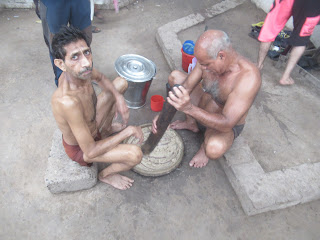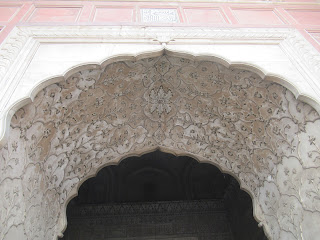Lahore Fort and Mosque
So much was shut that we couldn't see for one reason or another. The National Museum was another building on the schedule that was closed for a week due to pollution. We went to see something completely different. A wrestling match.
There is a large pit filled with sand. one of the wrestlers uses a hoe to pull the sand towards him to get some air into the sand to make it soft. Then using a log as a roller, the top is smoothed off and the wrestling can begin.
They have a special diet of crushed almonds, caraway seeds and other nut crushed into a paste with milk added.
Wrestlers warm up first. They use dumb bells and weights fhioned out of hard timber and perform exercises on the ground such as pressups and jumps.The wrestlers enter the ring and sit....
...whilst the first bout takes place. The rules are similar to wrestling at home. The idea is get both your opponent's shoulderson the ground.
Winners originally used brute force and weight to win but now the technique and skillful oves are more important.
The we went to the Badshahi Mosque. We walked aroung the drounds whilst we waited for the guard to let us in.. One of the minarets.
The rear wall of the main building. with its domes and minarets.
A view along a side facade.
The side of the main structure...
...and a full frontal. It is built solely of red sandstone from Johdpur, currently in India and white marble. It was constructed 1671 - 73.
The view opposite the main structure. The minarets on the corners had there tops removed and were used for cannons during the Anglo-Sheikh Wars. They have since been renovated according to the original plan.
They have a special diet of crushed almonds, caraway seeds and other nut crushed into a paste with milk added.
Wrestlers warm up first. They use dumb bells and weights fhioned out of hard timber and perform exercises on the ground such as pressups and jumps.The wrestlers enter the ring and sit....
...whilst the first bout takes place. The rules are similar to wrestling at home. The idea is get both your opponent's shoulderson the ground.
Winners originally used brute force and weight to win but now the technique and skillful oves are more important.
The we went to the Badshahi Mosque. We walked aroung the drounds whilst we waited for the guard to let us in.. One of the minarets.
The rear wall of the main building. with its domes and minarets.
A view along a side facade.
The side of the main structure...
...and a full frontal. It is built solely of red sandstone from Johdpur, currently in India and white marble. It was constructed 1671 - 73.
The view opposite the main structure. The minarets on the corners had there tops removed and were used for cannons during the Anglo-Sheikh Wars. They have since been renovated according to the original plan.

A detail of the side wall.
A close up of the main entrance.The decoration within the main arch.
An alcove.
Some internal roof decoration.
A view along one of the side aisles.
The Pakistani Tower erected after the Lahore Resolution which was passed to start the independence process.
The gate into the Lahore Fortress seen from the mosque.
Then we entered the fort by a side gate into the grounds and up some steps.
A view across the gardens.
The court.
A closer view of the Dewan-E-Aam. It was used as a court to hear cases, pass down judgement and to see the punishment. It was open to the public to see justice being handed down.
The judge or king, depending on the case, sat on the raised dias in the middle. Lawyers would stand either side of him.
Behind the court was a large square. Down each side was the harem, where the king's wives lived. Typically, he had 21 wives.
On the far side from the court was where the king lived.
Under the eaves were carvins of peacocks, elephants and tigers. Peacocks represented peace, elephants represented the Mughal empire and tigers indicted power. Winged tigers represented greater power such as the ability to achieve the impossible.
The Royal Court. This was where disagreements within the royal family were heard, in private away from the gaze of the public. The building is made of marble.
Around the top of the wall are embedded precious and semi-precious stones.
The fountain in the centre of the building was decorated in a similar way but all the stones have been prised out by plunders. The mughals lovedgardens and fountains. They only settled where there was water. hey soon took over Rohtas Fort after it was completed but never lived there as there was insufficient water and pressure for any fountains.
An intricate and delicate piece of jali, lattice work. The window looked out over the river and the lattice gave some privscy but allowed any air current to circulate.
The royal hamman, with hot and cold sections. It used to have a dome above this area but a stray shell from a cannon mounted on top of the neighbouring mosque's minaret hit it and destroyed it. An early example of friendly fire.
Entrance into the Sheesh Mahet.The decoration at the top of the dome.
This was where the king was entertained. He sat on the dias behind the marble columns.
The musicians sat to one side and there was dancing in the square.
At the far side was an interesting feature. The alcoves had lanterns placed in them and there was a curtain of water falling in front of the lanterns that gave a twinkling light behind the water.
We were approaching the original entrnce. The steps are low and deep. When the king arrived, he rode aboard an elephant, so the steps had to be made so that an elephant could walk up them.
This wasn't good enough for the British to move troops, cavalry and cannon, so they built an alternative sloping access to the fort.
The original entrance, the Shah Burj Gate, high enough to accommadate an elephant and howdah...
...the facade next to the Shah Burj Gate.
The British also added defences although this gate wouldn't allow an elephant to pass.
The new main entrance. It was built so that there was a direct route from the fort to the mosque.
And just in front of the entrance is the tomb of Muhannad Iqbal, the national poet who from his grave had caused so many sights to be shut.












































No comments:
Post a Comment